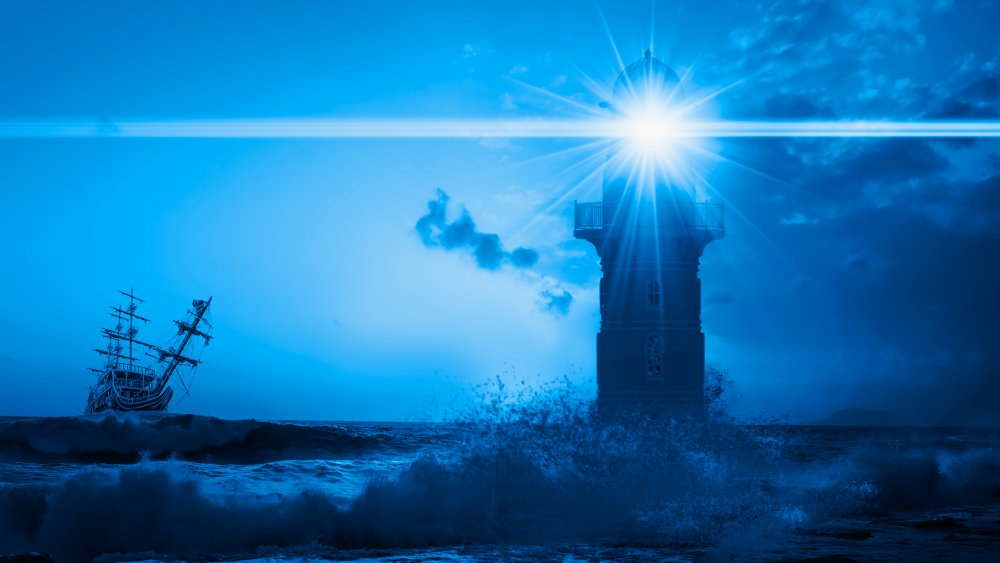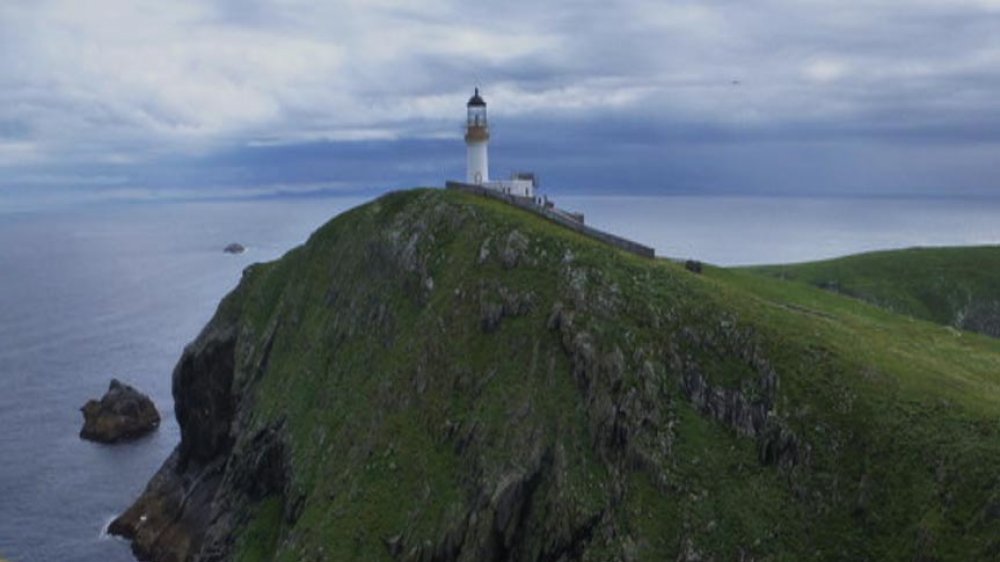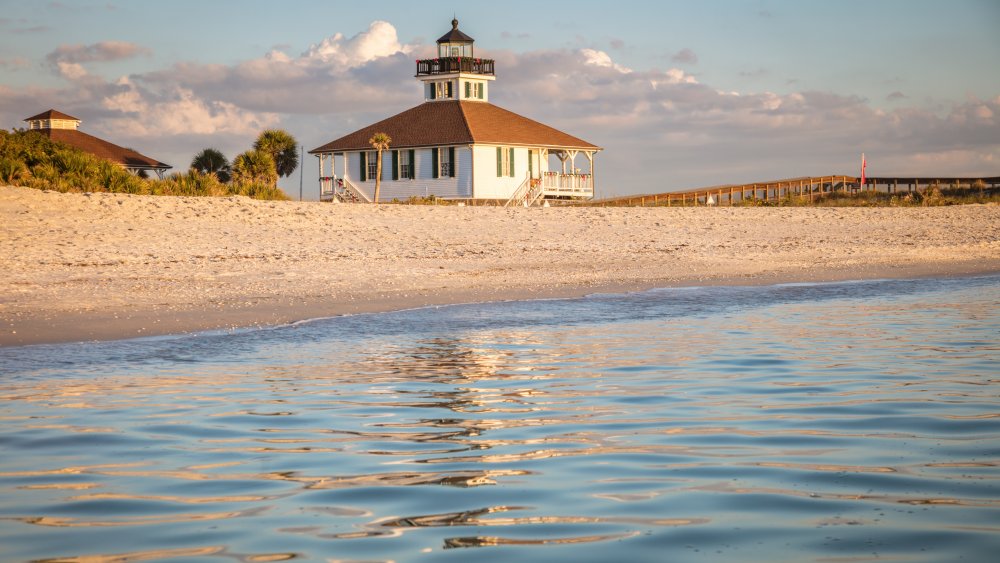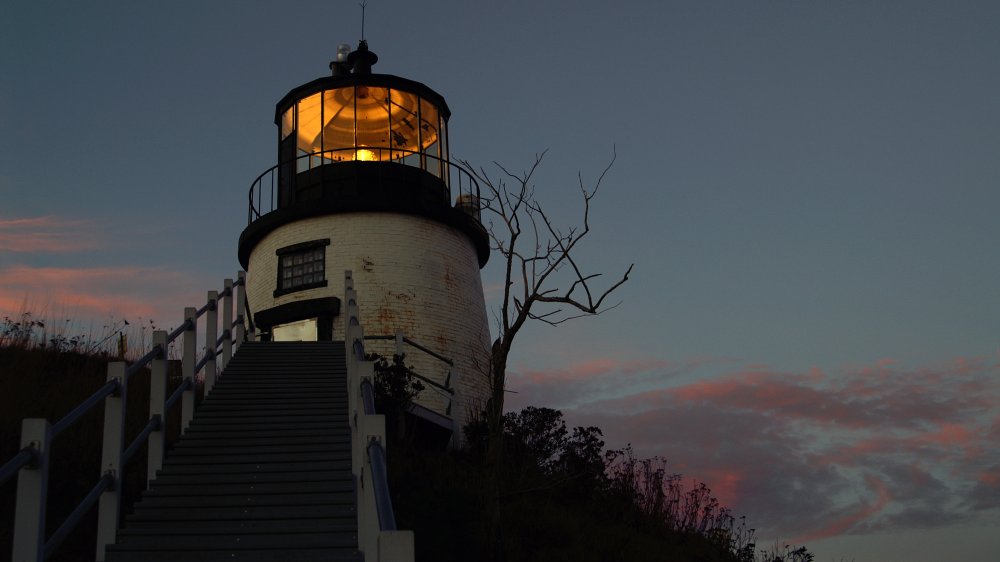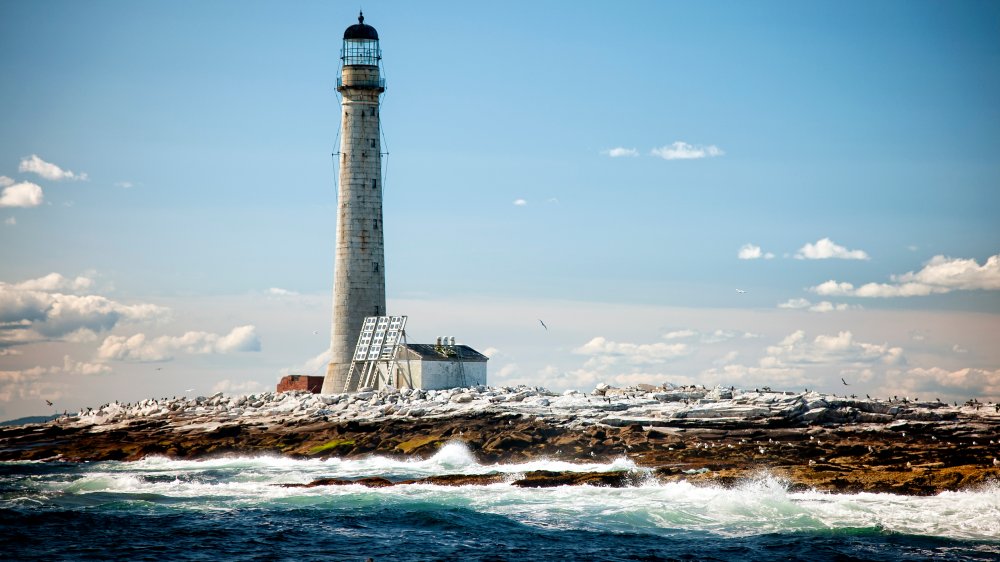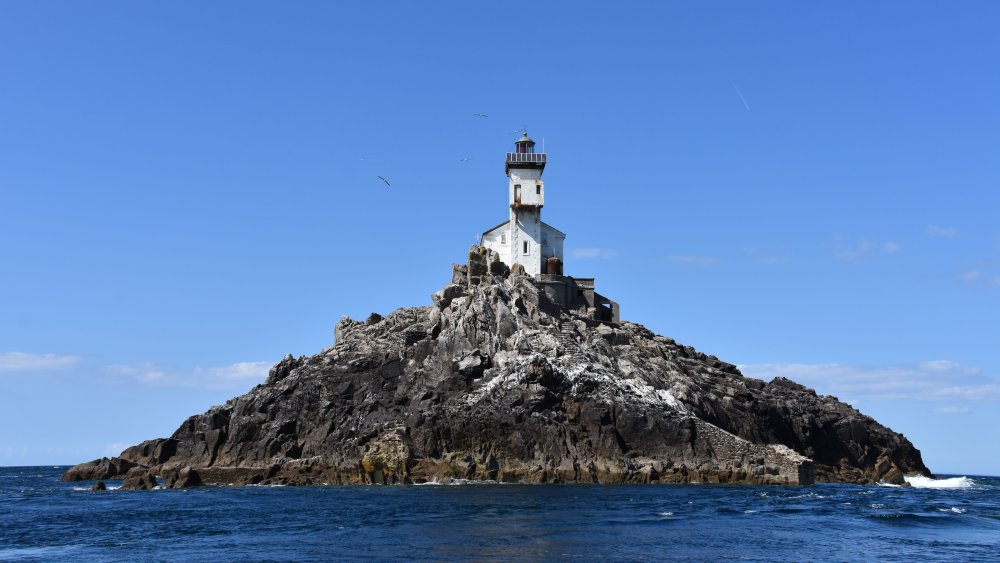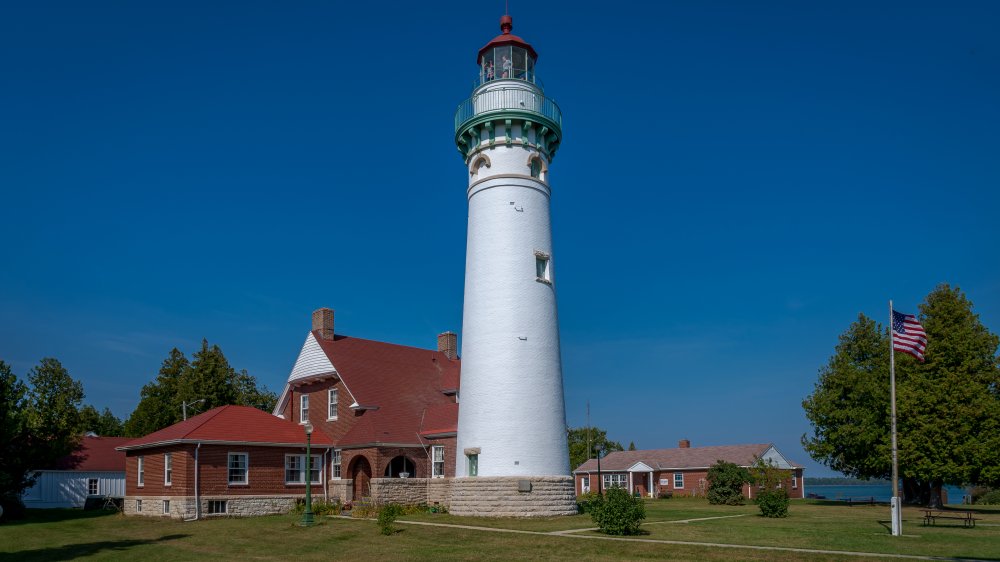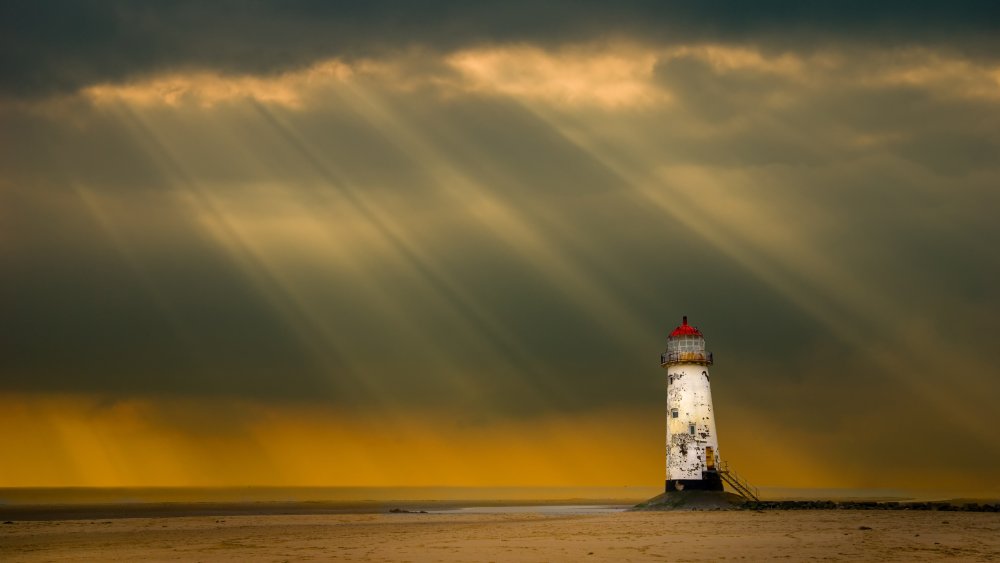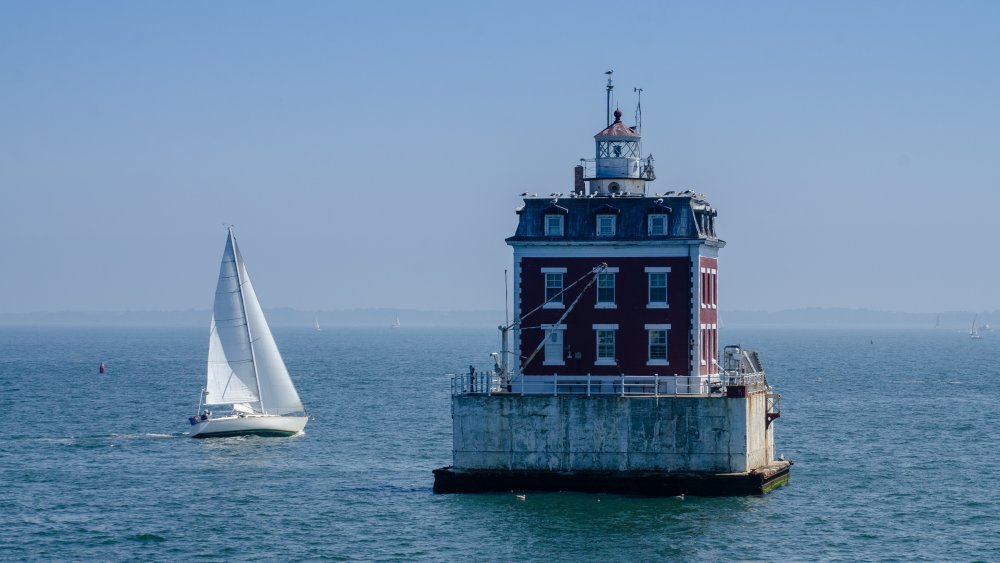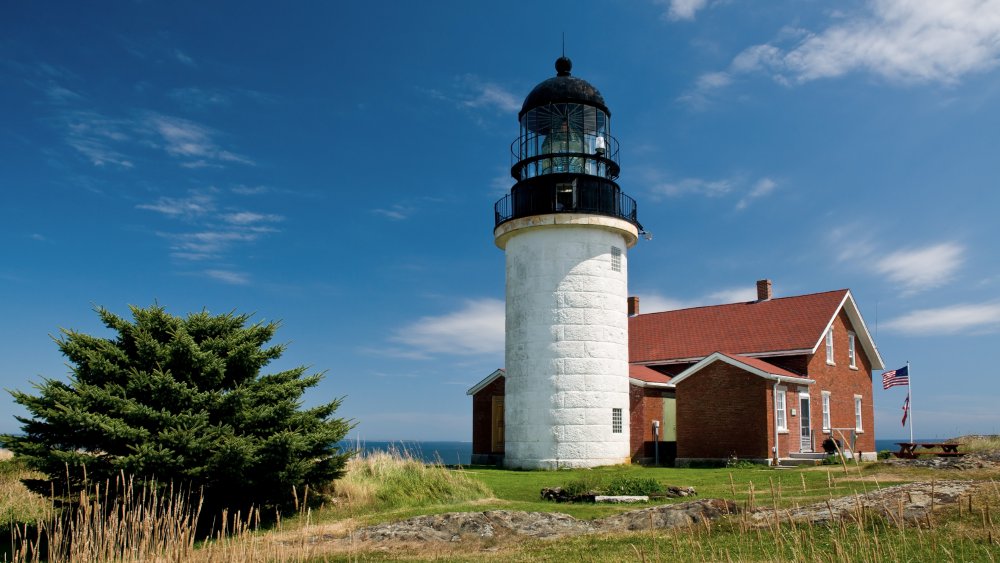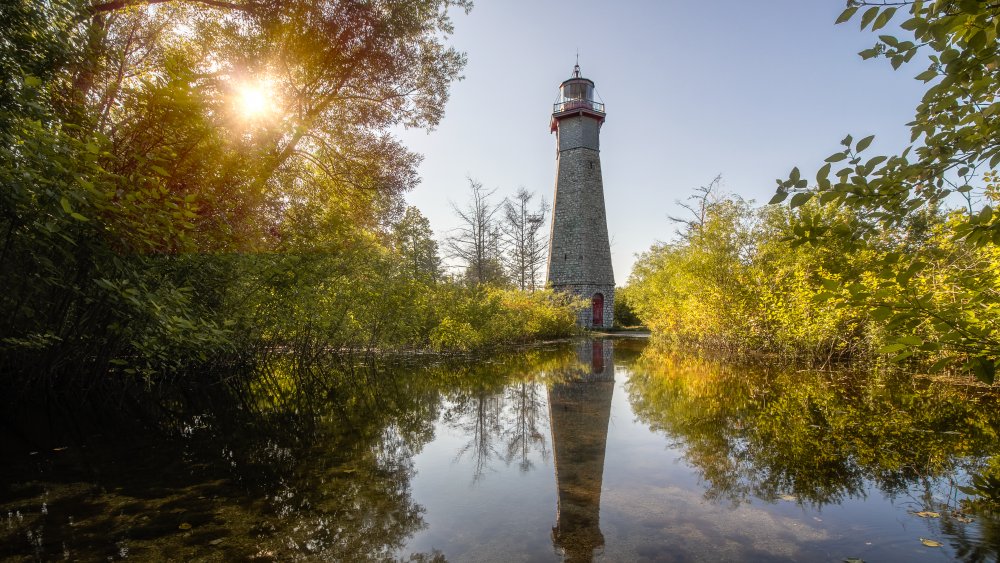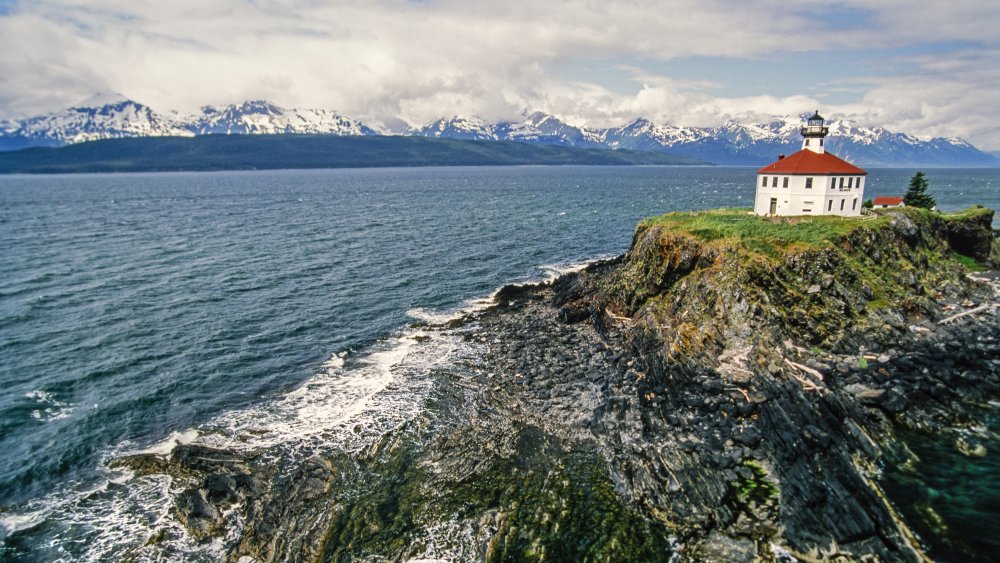Creepy Tales Of Lighthouse Ghosts
It's absolutely undeniable that some places just have something of a creep factor about them. Lighthouses? Yes, they're definitely on the list.
Lighthouses are, of course, meant to keep ships safe, and according to Project Archaeology, the earliest ones — dating back to Ancient Egypt — were probably nothing more than bonfires on the beach. We've come a long way since then, and while modern lighthouses are usually automated, there were entire centuries where lighthouses were reliant on a keeper — along with an assistant or two, and sometimes his family — to keep the beacon lit.
And that? That's a job with no days off, one that lasts year-around, and one that would get not only repetitive, but pretty lonely, too. It's no wonder, then, that there's a ton of stories of lighthouses being the scenes of horrible accidents, tragedies, and deaths... and sometimes? Sometimes they're not accidents at all, but they are bad enough to keep those involved from moving on. Here's some of the creepiest tales of lighthouses with residents who are no longer among the living.
The storm that made grown men cry
Eilean Mor is in the Scottish Hebrides, and it's been thought to be cursed for a long time — even St. Flannan fled the island after building a little chapel there, saying he was haunted by unknown creatures. Still, their lighthouse was completed in 1899, and on December 15, 1900, a ship called the Archtor reported that the light was no longer shining. When someone went to investigate, they found the fireplace hadn't been lit in a while, clocks were stopped, and the three keepers were gone.
According to Ozy, it wasn't until 1965 that the lighthouse log's final entries were made public. The writer described a storm so otherworldly it had reduced one of the veteran keepers to sobbing and praying in a corner. The log ended with: "Storm ended. Sea calm. God is over all."
So... what happened? Are the logs real? Was there a storm that killed some or all of the keepers? Was it used as a cover for murder? Historic UK says that it gets weirder: there were no storms reported in the entire region on those days. If there was a storm, and they'd gone out to make sure supplies were secured, why were there two oil-skin coats left behind? And what happened to the bodies? The solution is likely to remain a mystery... unless one of the island's disembodied voices — often heard calling out the names of the dead men — is willing to finally tell their tale.
One small girl... and the ghost of a pirate's would-be conquest
Port Boca Grande Lighthouse sits on the south end of Florida's Gasparilla Island, and that island has a story that's connected to our ghosts. According to the Florida History Network, the island was named for a pirate called Jose Gaspar, who made his living hunting ships along the coast... and abducting women, who he would hold for ransom.
The lighthouse was built in 1888, more than a century after Gaspar prowled the coast. Still, one of the ghosts that keepers have reported seeing comes right out of his era. Coastal Breeze News says that in 1801, Gaspar captured a woman named Josefa de Mayorga. As the daughter of a Spanish Viceroy, her ransom would have netted him a pretty penny, but he became determined to have her on his arm instead of a ransom in his pocket. She repeatedly rejected him, though, and he ordered her beheading. Today, she's said to still walk the grounds, and be responsible for some of the lighthouse's more eerie occurrences (via Lighthouse Friends).
There's one more ghost that the Boca Beacon says lives there, and that's the spirit of a 5-year-old girl. She had loved living there with her family, and after she succumbed to a tragic illness, she decided that she never wanted to leave the lighthouse by the sea that she loved so much.
You're never too old to make new friends
Maine's Owls Head Lighthouse has a pretty neat history — it was approved by President John Quincy Adams way back in 1824, and in 1850, it was the place where a young couple were encased in ice created by the spray of a schooner off the coast, then rescued and brought back to life.
According to Lighthouse Friends, it's also a place where at least a few ghosts made regular appearances, including one called simply the Little Lady. She's the one that makes doors and silverware rattle, but it's the ghost of an old lighthouse keeper that's still making new friends from beyond the grave. Seeks Ghosts says that his footsteps often appear after periods of snow or rain, and anyone who watches them make their way up the stairs will see the lighthouse door open and close... even if it's locked.
In the 1980s, a new keeper moved in with his family, including his 2-year-old daughter, Claire. One day, Claire told them, "Fog's rolling in! Time to put the foghorn on!" Where she'd learned that, they had no idea — but over the following two years, she started to share more stories about her friend — an older, bearded man who wore a seaman's cap and a heavy blue coat. That's when they started to suspect that the stories they'd heard about the hauntings were true, and their daughter had befriended a previous keeper.
Just a mother still searching for her long-dead child
The Heceta Head Lighthouse stands on an Oregon cliff and for decades, it's been home for not just keepers, but their wives and children as well. Unfortunately, at least one family suffered an unthinkable tragedy: the loss of a child. It's said that their mother still remains at the lighthouse, and according to CBS 13 KVAL, she's looking for that child.
Those who see her — or experience her presence — call her Rue, after a group of college students playing with a Ouija Board spelled out that particular name. It's said that one of her children drowned — either in the lighthouse's cistern, or in the ocean — and she remains. To add to the eeriness factor, there is, in fact, an unmarked grave off a short distance into the nearby trees.
They say that Rue isn't evil or malevolent, but that she's definitely set in her ways. She'll occasionally appear — she wears a dark dress and has long, silver hair — but more often, she'll express displeasure at the presence of guests or changes. Monterey Boats says that when it came time to paint the lighthouse, she definitely didn't approve and made that perfectly clear by setting off all the fire alarms. Keepers shut off the alarms and removed the batteries... but they still continued to ring.
It's enough to make you believe in curses
It might be called Boon Island, but according to New England Lighthouses, there's been a lot of dark stuff that's happened there — most famously, a 1710 shipwreck that stranded survivors on the island for three weeks, and forced them to resort to cannibalism to survive. Once the lighthouse was built, well, it didn't get much safer. Early versions of the lighthouse were built, destroyed, rebuilt, and destroyed again, and as for hauntings? There's plenty, including one tale that begins in the 1840s.
That's when SeaCoast says the aptly-named keeper Luke Bright moved to the island with his new bride, Katherine. It wasn't long before a storm hit; Luke, knowing he needed to get from their home to the lighthouse, tied a rope around his waist and ventured out. He slipped, fell into the ocean, and drowned. The rope held, though, and Katherine dragged his body back home.
For days, Katherine alternated between sitting with her husband's body and climbing the lighthouse tower. She kept her now solitary watch for five days until she ran out of fuel, and was discovered by fishermen who went to see why the light had gone out. It was -10 Fahrenheit on the night they found her, and she died shortly after. She's still seen on the darkest of nights, though, a ghostly apparition that floats into the lighthouse. Sometimes, lights and foghorns go on by themselves, almost as though she's still keeping her vigil.
Home to much, much more than your regular old ghost
There's a lighthouse off the coast of Brittany that's as deadly as it is gorgeous: it's the Tevennec lighthouse, and where it stands on a tiny, rocky island? It seems like it defies all logic... and sanity.
According to Complete France, the lighthouse was built in 1875, and the island already had a deadly reputation: sailors who got caught unaware would be swept away by a current that inevitably led to being bashed on the island's jagged rocks, giving rise to the legend that it was occupied by none other than Ankou — Death — himself. The fate of the first lighthouse keeper does nothing to debunk that: Henri Guezennec immediately started hearing ghostly, disembodied voices, and went mad. The next two lighthouse keepers died mysteriously, and the fourth? He slit his own throat.
Priests were even called in to perform exorcisms on the island, but it didn't seem to work... even when in 1893, crucifixes were embedded directly into the rocks. Four years later, a family moved in, and while Atlas Obscura says they didn't report any ghosts, plans were still made to make Tevennec completely automated as early as possible: in 1910. It's probably for the best.
It's important to pay your last respects
Michigan's Seul Choix lighthouse stands along a particularly dangerous stretch of coastline — even with the beacon being built in 1892, there's still been around a dozen shipwrecks and 500 deaths along the stretch.
One of the men responsible for overseeing the lighthouse was Joseph Willie Townsend. He was the keeper between 1902 and his death in 1910, and some say that he's still there. How do they know? For starters, 99WFMK says that he's still smoking the cigars that his wife had hated — and visitors can still smell the smoke that she despised. According to those who work there today (via America's Haunted Road Trip), Townsend's spirit is a bit of a joker. He's fond of moving the silverware, and he reportedly leaves indentations in the bed where he lies down for a nap. Some have even seen him walking the grounds or looking out of a lighthouse window, but that brings up another question: what is it that keeps him there?
Pure Michigan suggests it might have something to do with the amount of time he laid in state in the lighthouse before his family could reach him to pay their last respects, and give him a proper burial. He remained there for almost three weeks, and it's possible that he realized he was so comfortable, he might as well stay.
Is an ill-fated lighthouse keeper trying to get visitors to join him?
The Point of Ayr Lighthouse — also called the Talacre Lighthouse — was built in 1776, and it's been abandoned for a long, long time: since around 1840, says Atlas Obscura. You can only reach it — or return from it — during low tide, when the footpath is accessible. And you'd probably want to keep an eye on that as you don't want to get stuck staying the night: some visitors have reported some eerie happenings that suggest the ghostly entity of the lighthouse's last keeper might be trying to drag new souls into the afterlife to keep him company.
According to the stories (via the BBC), plenty of people have seen a man walking around the tower, footprints appearing out of thin air on the beach, and some have even seen the flickering beam of a flashlight within the locked and sealed lighthouse. It's thought to be the ghost of the last keeper, a man named Raymond. Raymond, it's said, died of a fever, and here's where things get weird.
Some people have reported going to visit the lighthouse, and suddenly feeling incredibly sick — usually with a fever. When one family went there on holiday with their five children, their visit was cut short when four came down with a high fever and tonsillitis. They'd had no idea that the last keeper had died of a fever, and while they all recovered... was Raymond beckoning?
The lonely ghost of a lighthouse keeper's grief
The New London Ledge Lighthouse is a little different than most — according to Astonishing Legends, it was built on a man-made island in 1909. Why? It was needed to help control the growing amount of traffic going in and out of the Connecticut Harbor.
Over the years, those working at the lighthouse have reported all kinds of eerie phenomenon: some have woken up in the middle of the night to hear someone calling their name, while others have heard ghostly footsteps. Doors open and close by themselves, and fortunately for workers, the ghost is a helpful one, and sometimes even mops the floor, polishes brass, and cleans the windows.
He's called Ernie, even though the general consensus is that it's not his real name. He seems fine with it, though, and seems perfectly content... unlike he was in life. The story goes that he was a lighthouse keeper sometime in the 1920s or 1930s, at a time when 3- or 4-man crews tended the beacon. While he was at the lighthouse, his wife ran away with another man. Heartbroken, he decided to end it all: he climbed to the top of the building and jumped. His body was never recovered.
She kept on playing, over and over and over...
Tending a lighthouse with 21st century technology might not be so bad. You could fill the hours with cat videos and MMOs, so that would be a win. Back when most lighthouses were still manned by actual people, though, there were fewer ways to fill the hours between tending the lights... as a couple tending Maine's Seguin Lighthouse discovered in the mid-1800s.
According to the Press Herald, the lighthouse keeper bought his wife a piano, in hopes of filling some of her time — and undoubtedly, the silence — with music. The piano arrived, and she chose her favorite song. She practiced the same song, over and over and over... and over... and over... The keeper suggested she play a different song, and volunteered to order her new sheet music, but she refused, and kept playing. Over. And over. The repetition drove the keeper mad, and he took an ax to both the piano and his wife. When the music stopped and he snapped out of his murderous rage, he realized what he had done... and killed himself. Those who visit the island today often report they can still hear the tinkling of the piano.
It's unclear whether or not that's the keeper that appeared to volunteers in 1985, who were removing furniture after the lighthouse had been decommissioned. The man — wearing olde-timey oilskins — told them to leave his home alone. They didn't, and later, the boat full of furniture sank.
A cautionary tale about who you invite inside
The Gibraltar Point Lighthouse stood vigil over the Toronto Harbor since the city was called York, and that's a long time. According to The Star, it was active from 1808 until the late 1950s, and even though the coastline has shifted to leave it well away from the water, it's thought that the lighthouse's very first keeper is still there, haunting the place where he met his grisly end.
His name was J.P. Radan Muller (or Rademuller, says Torontoist), and according to the story, he vanished in 1815. There were two different stories about what happened to him: both involve him serving alcohol to local soldiers. In one version, he watered down the beer and charged full price — when the soldiers realized they'd been conned, they returned for the ultimate revenge. In the other version, Radan Muller was serving them in his home, and when he tried to close, a fight broke out and he was killed. Whatever happened, the result was the same: the keeper was killed, dismembered, and buried in a few graves near the lighthouse.
But it's just a story... right? Maybe not. It was first written down in 1908 by a historian that doubted the authenticity of it, but it was still enough to convince the lighthouse keeper at the time that he might as well do a little digging. What'd he find? A jawbone, so... there's that.
Not all ghosts are of the living
The lighthouse at Alaska's Eldred Rock was built between 1902 and 1906, years after the tragedy that had convinced Congress and the Lighthouse Board that a lighthouse was, indeed, needed there.
It was 1898 when the Clara Nevada — loaded with dynamite, around 100 fortune-seeking passengers, and about 800 pounds of gold that came courtesy of the Alaskan gold rush, left Skagway for Seattle. She never made it: just 30 miles into the journey, she collided with Eldred Rock, burst into flames, and sank. While it was widely reported that there were no survivors, one of the ship's skiffs was later discovered and the ship's captain and fireman later resurfaced. What never turned up? The gold.
According to Lighthouse Friends, it was never officially ruled as sabotage, but it did lead to the building of the lighthouse. And here's the weirdness. On March 12, 1908 — almost 10 years to the day from the sinking of the Clara Nevada — a massive storm swept across the island and the lighthouse. When the keeper emerged the next morning, he was stunned to see an actual ship beached on the island's shore. It was a ghost ship: the Clara Nevada. The storm had picked her up from the bottom of the ocean and dumped her on the beach — that same evening, the water reclaimed her. She's now a popular dive spot.
